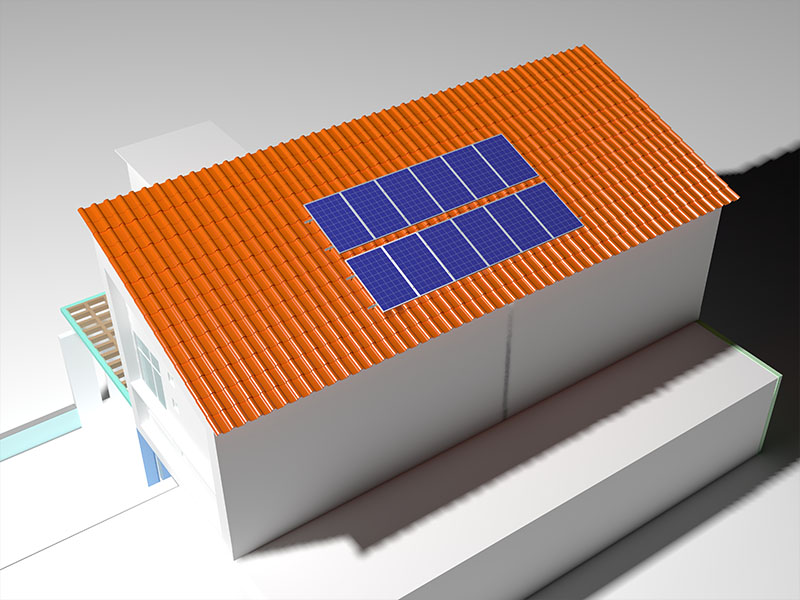Photovoltaic mounting structure is an important part of photovoltaic power station, carrying the main power generation of photovoltaic power station. Therefore, the choice of solar mounting structure directly affects the operation safety, damage rate and construction investment income of photovoltaic modules.

When choosing a photovoltaic mounting structure, it is necessary to choose a solar mounting structure of different materials according to different application conditions. According to the different materials used for the main force-bearing rods of the photovoltaic mounting system, it can be divided into aluminum alloy mounting structure, steel mount and non-metal mount (flexible mount), of which non-metal mount (flexible mount) is less used, and aluminum alloy mount And steel brackets have their own characteristics.
The non-metal mount (flexible mount) is a steel cable prestressed structure to solve the span and height requirements of sewage treatment plants, complex terrain mountains, low-load-bearing roofs, forest-light complementary, water-light complementary, driving schools, expressway service areas, etc. Limit the technical problems that the traditional mount structure cannot be installed, and effectively solve the existing difficulties in the construction of photovoltaic power plants in valleys and hills, serious sun shading, and low power generation (compared with photovoltaic power plants in flat areas, it is about 10%-35% lower) ) The disadvantages of the power station mount are poor quality and complex structure.
In general, the non-metal mount (flexible mount) has a wide range of adaptability, flexibility of use, effective safety and perfect secondary land use economy, which is a revolutionary creation of photovoltaic mounting structure.
A reasonable form of photovoltaic mounting structure can improve the system's ability to resist wind and snow loads. Reasonable use of the characteristics of the photovoltaic ground mounting system in terms of load can further optimize its size parameters, save materials, and further reduce the cost of photovoltaic systems.

The loads acting on the foundation of the photovoltaic module mount mainly include: self-weight (dead load) of the mount and photovoltaic modules, wind load, snow load, temperature load and earthquake load. The controlling effect is mainly wind load, so the foundation design should ensure the stability of the foundation under the wind load. No damage occurs.
So, what are the types of ground photovoltaic mounting system foundations and flat roof photovoltaic mounts foundations? What are their characteristics?
Roof photovoltaic mounting foundation
Bored cast-in-situ pile foundation: It is more convenient to form holes, and the top elevation of the foundation can be adjusted according to the terrain. The top elevation is easy to control, the amount of concrete reinforcement is small, the amount of excavation is small, the construction is fast, and the damage to the original vegetation is small. However, there are on-site hole forming and pouring of concrete, which are suitable for general filling, cohesive soil, silt, sandy soil, etc.

Steel spiral foundation: it is easy to form holes, the elevation of the top surface can be adjusted according to the terrain, and it is not affected by groundwater. It can be constructed as usual under winter weather conditions, with fast construction, flexible elevation adjustment, little damage to the natural environment, and no filling and excavation works. The damage to the original vegetation is small, and field leveling is not required. Suitable for deserts, grasslands, tidal flats, next door, frozen soil, etc. However, the steel used is relatively large, and it is not suitable for strong corrosive foundations and rock foundations.
Independent foundation: the strongest ability to resist water load, resist flood and wind. The amount of reinforced concrete required is the largest, a lot of labor, a large amount of earthwork excavation and backfilling, a long construction period, and great damage to the environment. It is rarely used in photovoltaic projects.
Reinforced concrete strip foundation: This type of foundation is mostly used in the foundation with poor bearing capacity, suitable for flat uniaxial tracking photovoltaic mounts in areas with relatively flat sites and low groundwater levels, and with high requirements for uneven settlement.
Prefabricated pile foundation: Prestressed concrete pipe piles with a diameter of about 300mm or square piles with a cross-sectional size of about 200*200 are driven into the soil, and steel plates or bolts are reserved on the top to connect with the front and rear columns of the upper mount. The depth is generally less than 3 meters. Relatively simple and fast.
Bored cast-in-place pile foundation: The cost is low, but the requirements for the soil layer are high. It is suitable for silty soil with a certain degree of density or plastic and hard plastic silty clay. It is not suitable for loose sandy soil layers. Harder pebbles or gravel may have problems forming holes less easily.
Steel screw pile foundation: special machinery is used to screw it into the soil, the construction speed is fast, no site leveling is required, no earthwork and no concrete, and the vegetation in the site is protected to the greatest extent. The height of the mount can be adjusted according to the terrain, and the screw pile can be reused.

Flat roof photovoltaic mounts foundation
Cement counterweight method: pouring cement piers on the cement roof, which is a common installation method, has the advantages of being stable and does not damage the roof waterproofing.
Prefabricated cement counterweight: compared with the production of cement piers, it saves time and saves cement embedded parts
